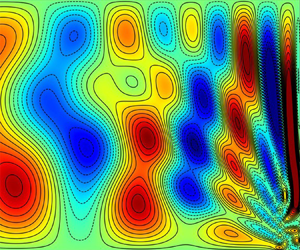No CrossRef data available.
Published online by Cambridge University Press: 15 March 2021

In an earlier paper, Oruba et al. (J. Fluid Mech., vol. 818, 2017, pp. 205–240) considered the primary quasi-steady geostrophic (QG) motion of a constant density fluid of viscosity  $\nu$ that occurs during linear spin-down in a cylindrical container of radius
$\nu$ that occurs during linear spin-down in a cylindrical container of radius  $L$ and height
$L$ and height  $H$, rotating rapidly (angular velocity
$H$, rotating rapidly (angular velocity  $\varOmega$) about its axis of symmetry subject to mixed rigid and stress-free boundary conditions for the case
$\varOmega$) about its axis of symmetry subject to mixed rigid and stress-free boundary conditions for the case  $L=H$. Direct numerical simulation (DNS) of the linear system at large
$L=H$. Direct numerical simulation (DNS) of the linear system at large  $L= 10 H$ and Ekman number
$L= 10 H$ and Ekman number  $E\leqslant \nu /H^2\varOmega =10^{-3}$ by Oruba et al. (J. Fluid Mech., vol. 888, 2020, p. 44) reveals significant inertial wave activity on the spin-down time scale. That analytic study, for
$E\leqslant \nu /H^2\varOmega =10^{-3}$ by Oruba et al. (J. Fluid Mech., vol. 888, 2020, p. 44) reveals significant inertial wave activity on the spin-down time scale. That analytic study, for  $E\ll 1$, builds on the results of Greenspan & Howard (J. Fluid Mech., vol. 17, 1963, pp. 385–404) for an infinite plane layer
$E\ll 1$, builds on the results of Greenspan & Howard (J. Fluid Mech., vol. 17, 1963, pp. 385–404) for an infinite plane layer  $L\to \infty$. At large but finite distance from the symmetry axis, the meridional (QG-)flow, that causes the QG-spin-down, is blocked by the lateral boundary, which provides the primary QG-trigger for inertial wave generation. For the laterally unbounded layer, Greenspan and Howard identified, in addition to the QG-flow, inertial waves of maximum frequency (MF)
$L\to \infty$. At large but finite distance from the symmetry axis, the meridional (QG-)flow, that causes the QG-spin-down, is blocked by the lateral boundary, which provides the primary QG-trigger for inertial wave generation. For the laterally unbounded layer, Greenspan and Howard identified, in addition to the QG-flow, inertial waves of maximum frequency (MF)  $2\varOmega$, which are a manifestation of the transient Ekman layer. The blocking of these additional MF-waves by the lateral boundary provides an extra trigger that complements the QG-triggered inertial waves. Here we obtain analytic results for the full wave activity caused by the combined trigger (
$2\varOmega$, which are a manifestation of the transient Ekman layer. The blocking of these additional MF-waves by the lateral boundary provides an extra trigger that complements the QG-triggered inertial waves. Here we obtain analytic results for the full wave activity caused by the combined trigger ( $\text {QG}+\text {MF}$) that faithfully capture their true character.
$\text {QG}+\text {MF}$) that faithfully capture their true character.